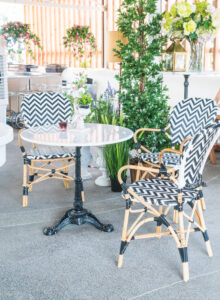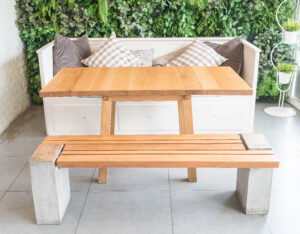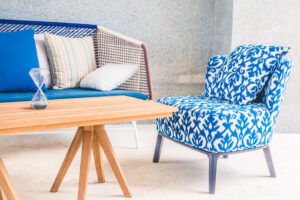For the most part, people fall somewhere between going for a minimalist or a maximalist approach for their outdoor space. They want to create a coherent design style that works but also doesn’t want their space to be too minimalist and uninviting.
It’s also true that people don’t always have the budget to give their garden a complete overhaul and will need to add pieces as and when they can over time. This can create a bit of a headache for some people in terms of being able to make all these varied colors, styles, and materials work. But the good news is that it is very possible to mix and match patio furniture.
Below is a comprehensive guide on how to mix and match outdoor furniture, with more detailed information about which materials work well together, which pieces to choose for your space, and how to build a color scheme that works for you.
The rule of three
As we’ve outlined above, it is very possible to mix and match outdoor furniture, even those that don’t look like they would work together. But in general, this only works within certain limits.
The best way to mix and match, and pull it off, is to stick to the rule of three. That means choosing three different material types, three principal colors, and three finishes – and then sticking within these boundaries.
For example, you can choose a mix of aluminum, rattan, and glass furniture and team this with three fabric choices for cushions, covers, table decorations, and more.
Three is a really important number in design terms. It shows careful consideration has been put in, emphasizing a discerning choice rather than just pairing two unbalanced materials together.

Balance the space
One way to ensure a harmonious mixing and matching of patio furniture is to try and use it in the right balance. That means thinking about your space and working out how best to arrange your seating and dining options. A well-balanced outdoor area can get away with a lot more in terms of mixing and matching materials than a cluttered or clumsy layout.
This can involve using a sectional sofa or loveseat as the centerpiece around which you can design the rest of your layout. You can then use accent chairs to add some contrast in terms of materials or colors.
If you have the space, then a large corner sofa or arrangement of two or more sofas can create an elegant and spacious conversation space, perhaps with a central fire pit so that your evenings can last a little longer.
Material contrasts
As we’ve mentioned above, mixing and matching are about finding the right balance. That means not going too overboard on your material choices.
While it might not be possible to limit yourself to just three material choices, you should try and follow the rule of three when it comes to primary materials. If you like, you can divide these into subsections. So, stick to three materials for your furniture choices, another three for soft furnishings, and another three for accessories and finishings.
Certain materials work very well together, such as rattan and glass, or wood and metals. So, try and choose materials that complement each other. But also, don’t be afraid to use contrasts to keep your outdoor lounge interesting.

Unifying colors
The same goes for colors. You might not be able to stick to the rule of three 100% but try having only three main principal colors. A and arrange them so that they tie the space together.
It might be a good idea to have one principle unifying color that runs throughout the space, and then supplement this with accent tones. This will help to create a more unified theme and give your space a more coherent appearance.
Accessories and finishing touches
You can also use accessories and finishing touches to unify any mixed and matched outside space. Think colorful flowers, statement plants, table settings, and more – all working to highlight accents and draw distinct pieces together.
You can also consider throwing cushions that unite two different styles of sofa, or a throw that softens a more modern style chair and makes it work with your other more rustic furniture. Little touches like this can go a long way toward making an eclectic style work.
Of course, don’t forget that your outdoor dining area or lounge is your own sanctuary in the open air, so try and add some personal touches.
It’s also worth thinking about how you keep your outside space looking its best. Use outdoor furniture covers, store furniture in a dry place during the off-peak season, and clean your outdoor furniture regularly. After all, it’s much easier to mix and match patio furniture when everything is in good condition and looking its best!







